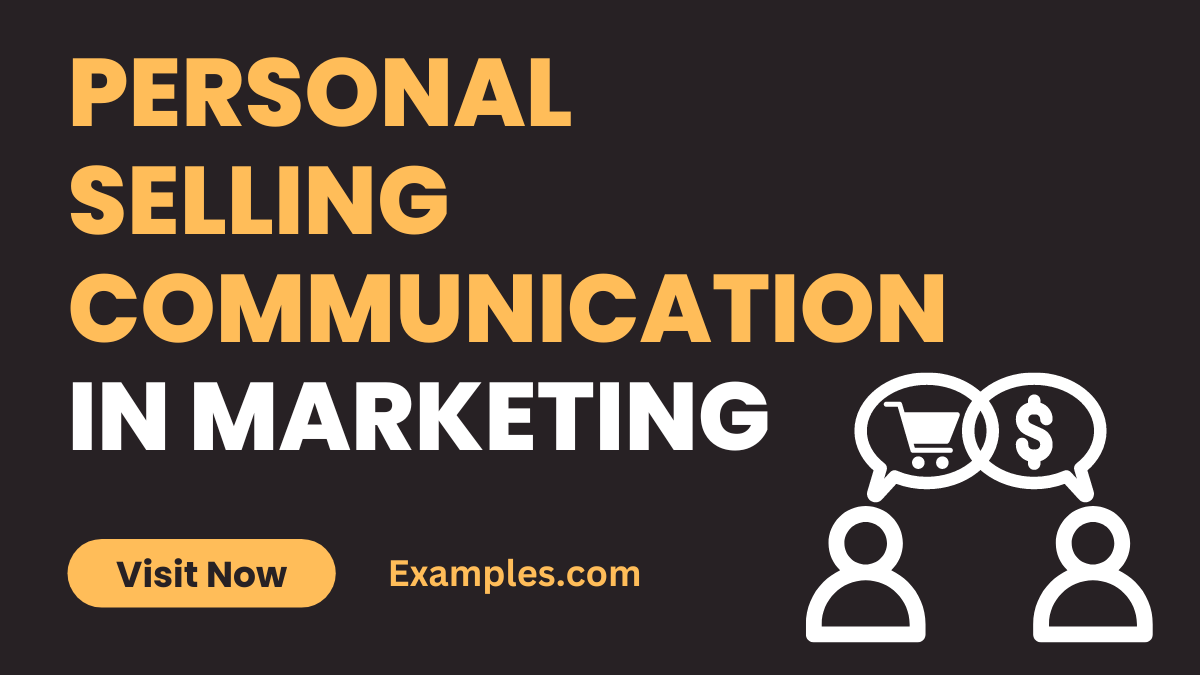19+ Personal Selling Communication in Marketing Examples
Personal Selling Communication in Marketing is an essential facet of effective sales strategies. This comprehensive guide delves into various communication examples and methods, illuminating the path to successful customer interactions. It covers everything from establishing rapport to closing deals, providing real-life scenarios and tools that empower sales professionals. Learn how to read customer cues and adapt your selling style to meet diverse needs, enhancing the overall sales process.
Download List of Personal Selling Communication in Marketing
What is Personal Selling Communication in Marketing?
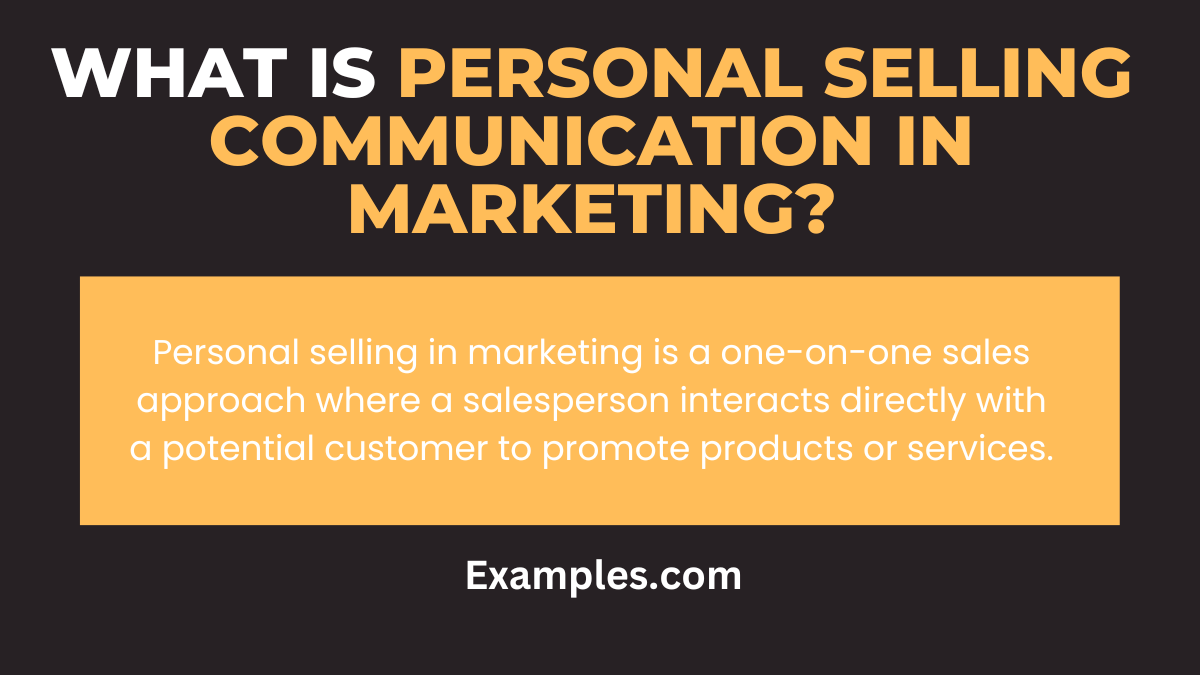
Personal Selling Communication in Marketing is a direct form of marketing where sales representatives interact with potential customers. This method focuses on building relationships and understanding customer needs through face-to-face or personalized interaction. The primary objective is to guide the customer through the buying decision, providing tailored solutions. Unlike other Types of Marketing Communication, personal selling is highly individualized and interactive, making it an effective strategy for complex or high-value products and services.
What is the Best Example of Personal Selling Communication in Marketing?
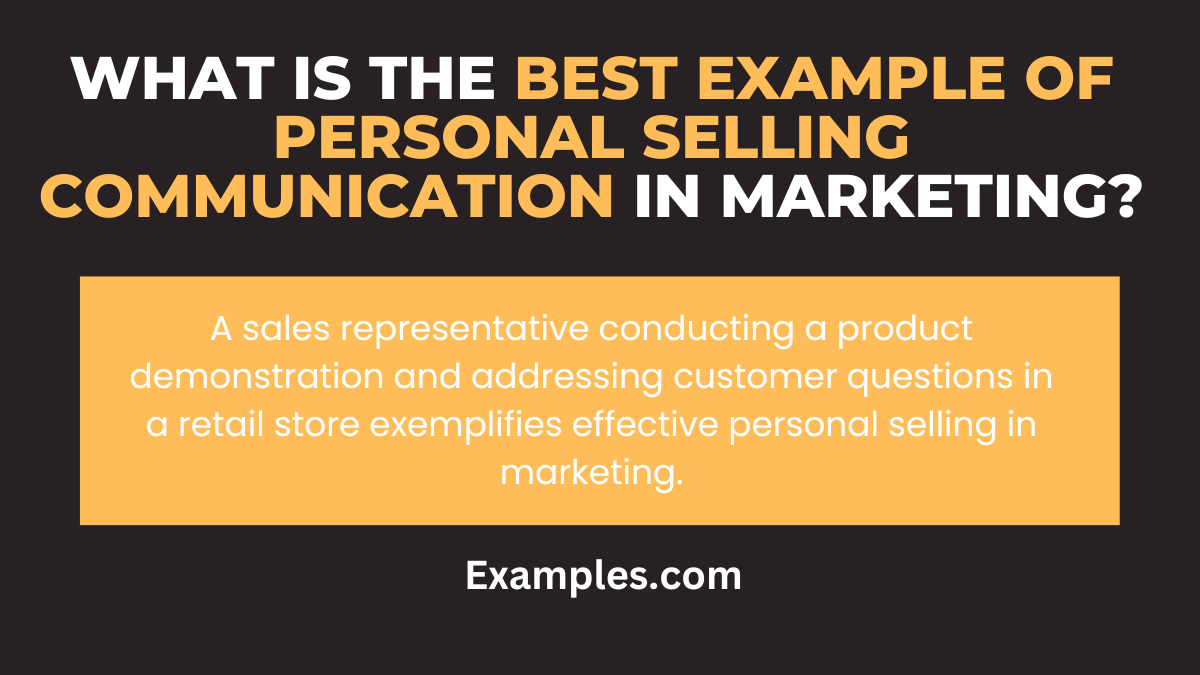
A classic example of Personal Selling Communication in Marketing is the car dealership experience. Here, a salesperson engages with a customer who is interested in purchasing a vehicle. The salesperson uses their expertise to assess the customer’s needs, preferences, and budget. They then present various car models, highlighting features relevant to the customer. The interaction includes test drives, discussion on financing options, and handling any objections or questions the customer may have. This personalized approach not only helps in making a sale but also builds a relationship, potentially leading to future business and referrals. This method exemplifies the essence of personal selling by combining product knowledge with customer understanding to create a customized buying experience.
20 Examples of Personal Selling Communication in Marketing
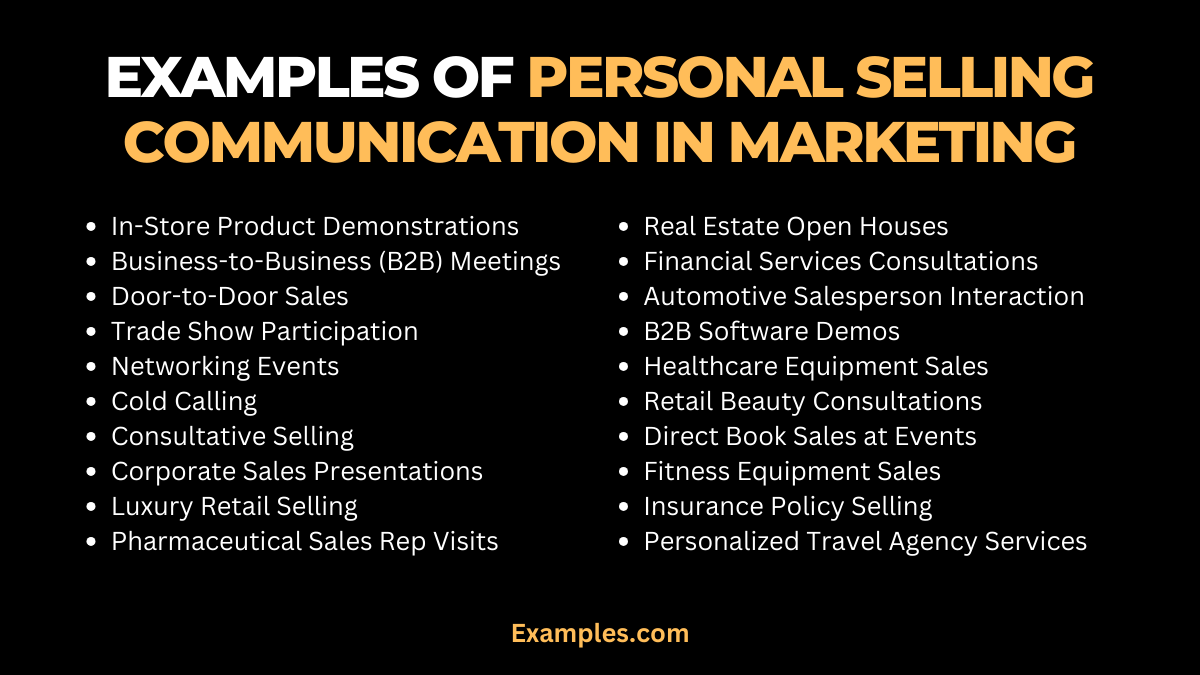
- In-Store Product Demonstrations: Salespeople demonstrate products, explaining features and benefits.
Response: Immediate customer engagement and potential on-spot sales. - Business-to-Business (B2B) Meetings: One-on-one meetings with business clients to discuss products or services.
Response: Building long-term business relationships and contracts. - Door-to-Door Sales: Visiting potential customers at their homes with product samples or demonstrations.
Response: Personalized interaction leading to direct sales. - Trade Show Participation: Interacting with attendees, showcasing products or services.
Response: Lead generation and networking opportunities. - Networking Events: Building relationships with potential clients in informal settings.
Response: Long-term relationship building and future sales opportunities. - Cold Calling: Reaching out to potential customers via phone.
Response: Appointment setting and initial interest generation. - Consultative Selling: Understanding customer problems and offering solutions.
Response: Establishing trust and positioning as a problem solver. - Corporate Sales Presentations: Tailored presentations to corporate decision-makers.
Response: Influencing large-scale purchase decisions. - Luxury Retail Selling: High-end products sold through personalized service.
Response: Creating exclusive experiences leading to high-value sales. - Pharmaceutical Sales Rep Visits: Visiting doctors to discuss new medications.
Response: Informing and influencing prescription decisions. - Real Estate Open Houses: Agents personally showcase properties to potential buyers.
Response: Building buyer interest and closing property deals. - Financial Services Consultations: Offering personalized financial advice and product solutions.
Response: Tailored financial planning leading to service sign-ups. - Automotive Salesperson Interaction: Engaging customers at dealerships, offering test drives and information.
Response: Influencing car purchase decisions. - B2B Software Demos: Demonstrating software capabilities to business clients.
Response: Facilitating software adoption and contract agreements. - Healthcare Equipment Sales: Direct interaction with healthcare professionals to sell medical equipment.
Response: Establishing long-term supply relationships. - Retail Beauty Consultations: Offering personalized beauty and skincare advice in stores.
Response: Immediate product sales and customer loyalty. - Direct Book Sales at Events: Authors selling and signing books at events.
Response: Direct sales and enhanced reader engagement. - Fitness Equipment Sales: Guiding customers in selecting the right fitness gear.
Response: Tailored solutions leading to purchase decisions. - Insurance Policy Selling: Offering tailored insurance solutions to individuals.
Response: Signing insurance policies based on customized needs. - Personalized Travel Agency Services: Crafting custom travel experiences for clients.
Response: Booking tailored travel packages.
Types of Personal Selling Communication in Marketing
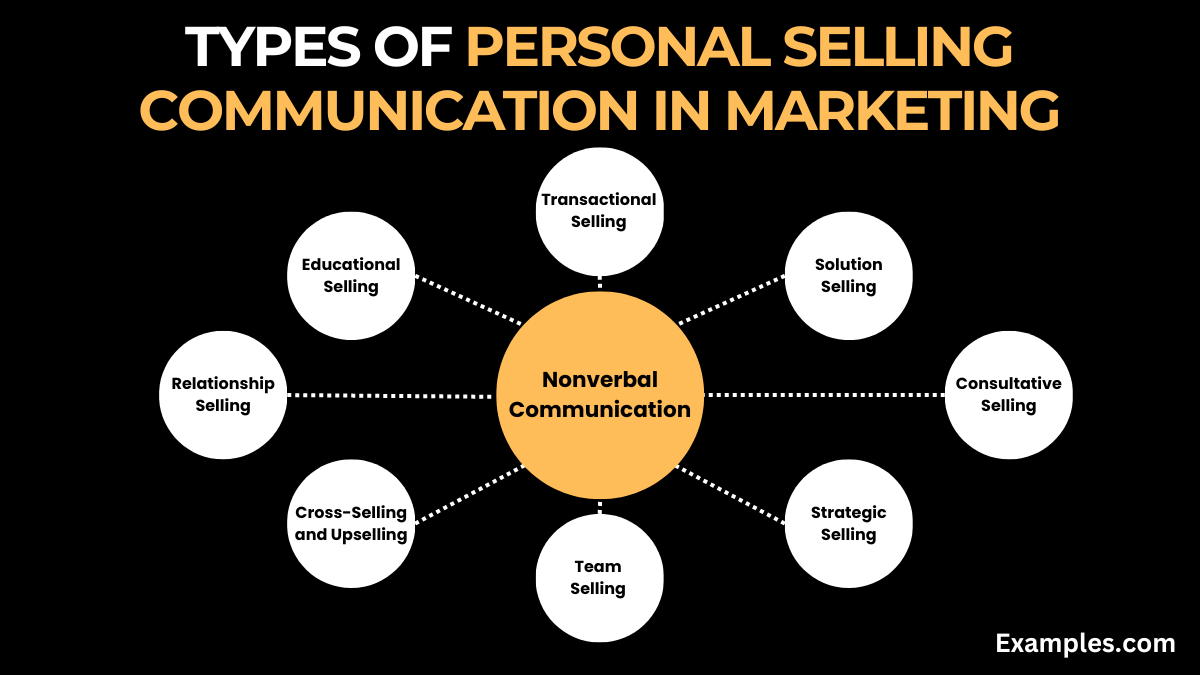
- Transactional Selling: Focused on short-term sales, this approach is about closing deals quickly without much emphasis on building relationships.
- Solution Selling: Salespersons identify and solve a specific problem the customer faces, using their product or service as the solution.
- Consultative Selling: Involves building a relationship with the customer, understanding their needs deeply, and providing tailored solutions.
- Strategic Selling: Aligns the sales approach with the customer’s long-term goals and strategies, often used in B2B environments.
- Team Selling: Involves multiple people from the sales team, each with different expertise, to convince larger clients or handle complex products.
- Cross-Selling and Upselling: Encourages customers to purchase related or premium products.
- Relationship Selling: Prioritizes building long-term customer relationships over immediate sales.
- Educational Selling: Focuses on educating the customer about the product or industry, building trust and authority.
Each type plays a crucial role in the Marketing Communication Strategies and contributes uniquely to achieving Marketing Communication Objectives.
Importance of Personal Selling Communication in Marketing
- Builds Strong Relationships: Establishes trust and rapport, leading to long-term customer loyalty.
- Customized Communication: Allows for tailored messages, addressing specific customer needs.
- Immediate Feedback: Salespersons receive instant responses, enabling quick adjustments.
- Greater Conversion Potential: Personal interaction increases the likelihood of sales.
- Market Insight: Direct customer interaction provides valuable insights into market trends.
- Flexibility: Sales strategies can be adapted on the go, depending on customer reactions.
- Brand Representation: Salespersons act as brand ambassadors, enhancing brand image.
- High Impact: Effective in complex or high-value sales where personal attention is crucial.
Personal selling is a key component inMarketing Communication Plans, significantly impacting the overall Marketing Communication Process.
Personal Selling Communication in Marketing Process
- Prospecting: Identifying potential customers who may benefit from the product or service.
- Preparation: Researching the prospect to tailor the sales pitch.
- Approach: Initiating contact in a way that resonates with the prospect.
- Presentation: Demonstrating how the product/service meets the customer’s needs.
- Handling Objections: Addressing any concerns or questions the prospect has.
- Closing the Sale: Persuading the prospect to make a purchase decision.
- Follow-Up: Ensuring customer satisfaction and nurturing the relationship post-sale.
- Referral Generation: Encouraging satisfied customers to refer others.
This process is integral to Personal Selling Communication in Marketing, effectively driving the Process of Marketing Communication and achieving desired outcomes.
Personal Selling Communication in Marketing Strategies
- Building Rapport: Establish a personal connection with potential clients to foster trust and understanding.
- Understanding Customer Needs: Engage in active listening to grasp the specific needs and preferences of each customer.
- Product Knowledge: Maintain thorough knowledge of the products or services being sold to confidently address queries and demonstrate benefits.
- Tailored Solutions: Customize the sales pitch to address the unique requirements of each customer.
- Effective Communication Skills: Use clear, persuasive language and non-verbal cues to convey messages effectively.
- Feedback Handling: Be receptive to customer feedback and adept at handling objections or concerns.
- Follow-up Strategies: Implement consistent follow-up to nurture leads and maintain customer relationships.
- Leveraging Technology: Utilize CRM systems and digital tools to manage customer interactions and enhance the sales process.
Advantage and Disadvantage of Personal Selling Communication in Marketing
Advantages:
- Direct Customer Engagement: Facilitates immediate feedback and adjustment of sales strategies.
- Strong Relationships: Builds lasting customer relationships based on trust and personal connection.
- High Conversion Potential: Personalized interaction increases the likelihood of sales conversions.
- Effective for Complex Products: Ideal for explaining and selling complex or high-value products.
- Flexible Communication: Allows for adjusting the sales message in real-time based on customer responses.
- In-depth Customer Insight: Provides valuable insights into customer behavior and preferences.
- Increased Customer Satisfaction: Personalized attention often leads to higher customer satisfaction.
- Potential for Upselling: Direct interaction creates opportunities for upselling or cross-selling.
Disadvantages:
- Higher Costs: Involves more expense compared to other marketing methods.
- Limited Reach: Can only engage with a limited number of customers at a time.
- Time-Consuming: Requires substantial time investment for each sales interaction.
- Dependency on Sales Skills: Success heavily relies on the individual’s selling skills.
- Potential for Inconsistency: Risk of inconsistent brand messaging across different sales representatives.
- Customer Resistance: Some customers may be resistant to direct selling approaches.
- Geographical Limitations: Physical presence limits the geographical reach.
- Vulnerability to Rejection: High chances of facing direct rejection, which can impact morale.
Personal Selling Communication in Marketing Techniques
- Consultative Selling: Focus on acting as a consultant rather than just a salesperson, by providing solutions to customer problems.
- SPIN Selling: Utilize the SPIN (Situation, Problem, Implication, Need-payoff) technique to guide the sales conversation.
- Relationship Selling: Prioritize building long-term relationships over immediate sales.
- Solution Selling: Emphasize how your product or service solves specific customer issues.
- Storytelling in Sales: Use compelling stories to create a more engaging and memorable sales pitch.
- Cross-Selling and Upselling: Identify additional needs of the customer and suggest complementary products or services.
- Referral Selling: Encourage satisfied customers to refer others, expanding the customer base.
- Using Sales Enablement Tools: Leverage tools like CRM software, data analytics, and digital content to support and enhance sales efforts.
When to Use Personal Selling?
Use Personal Selling Communication in Marketing when high-value transactions require personalized attention and building strong relationships is crucial. It’s ideal for complex products needing detailed explanation.
Humanize Your Sales Process with Personal Selling
Personal selling humanizes your sales approach, allowing for direct, empathetic interaction. It enhances the Marketing Communication Process by establishing trust and understanding between salesperson and customer.
Is Personal Selling a Two-Way Communication?
Yes, Personal Selling Communication in Marketing is inherently a two-way communication. It involves active listening and tailored responses, ensuring both the salesperson and customer contribute to the conversation.
Personal Selling Communication in Marketing is a cornerstone in the Marketing Communication Strategies, offering unique opportunities for direct customer engagement. It complements Direct Communication in Marketing, enhancing the overall Marketing Communication Process. This approach is vital in achieving Marketing Communication Objectives, especially in building lasting relationships and driving sales. Personal selling remains an invaluable part of the diverse Types of Marketing Communication.



